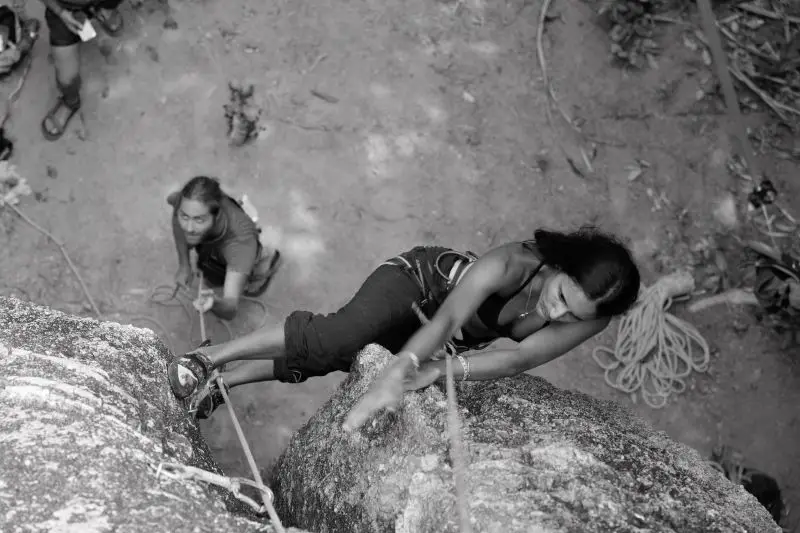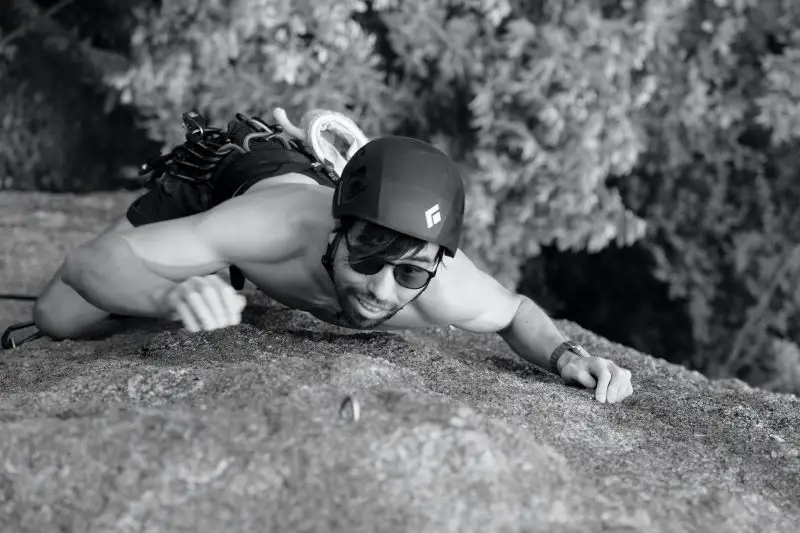A fiery debate has been happening since the beginning of modern climbing: lead climbing versus top rope. Or, to put it in the words of the purists: do you even climb if you don’t lead?
In rock climbing, here are two ways that you can send a route with a rope, and that’s by either top roping or lead climbing. Basically, when top roping, your rope will be going through the top anchor, and you’re going to be supported from above. When lead climbing, you’ll have to clip in your rope as you climb and secure the top only after you get there.
Chances are that when you’re going to start at your local gym or crag, you’re going to try top rope climbing as it’s more beginner-friendly, the belay technique is much easier, and you’ll get the hang of it much quicker.
Now let’s dive into the whole theory and see which one is the REAL version of rock climbing.
What Is Top Rope Climbing
As previously said, top roping is the climbing technique in which your rope is anchored at the top of the route (get it? top-roping) and then comes down to your belayer. With top roping, you’ll always have protection above you and never have to take a whipper when things do not go as planned.

While climbing top rope, your belayer will only have to take the slack and keep an eye on you while shouting some “allez” every now and then to keep your spirits up.
In terms of falling, you’ll experience a soft catch, so this type of climbing is safe and comfortable all the way.
Safety and comfort are two of the reasons beginner climbers usually learn climbing by top roping and also because it takes one, maybe two grades off the difficulty of the route you’re trying which is a great bonus.
What Is Lead Climbing
Appreciated by more experienced sport climbers, lead climbing is kind of the upgrade or the next step once you get comfortable on the wall. While it’s more intense regarding physical and mental effort, lead climbing is perceived as more fun.

When lead climbing, you’ll have to face more variables compared to top roping. First of all, you’ll have to clip into safety gear, also known as quickdraws, as you scale the wall, and believe it or not, it’s not as easy as it seems. Second, comes the mental or fear factor. While climbing lead, you won’t see the rope above you, and the falls are going to be bigger and scarier. As you proceed to clip into the quickdraw, if you happen to fall, you will go down a considerable distance, sometimes twice the distance you climbed due to the slack and rope elasticity.
Last but not least, while top roping you might feel that your belayer can give you an extra bump in order to pass the difficult section, whereas in lead climbing, your belayer will only be there to catch you in case of a fall, and of course, keep the hype up.

Top Rope vs Lead Climbing: Key Differences
Of course, there are some similarities and differences between top rope and lead climbing, but apart from scaling a wall, what could those be?
Moves
In general, the moves are 90% the same whether you are top roping or leading. They do slightly vary when the climber needs to find a position to take one hand off and clip the draw.
Projecting
Both beginner climbers and more seasoned ones will spend some time top roping. While lead climbing is considered the way to fully send a line, some climbers who don’t intend to flash a route will spend time projecting, hangdogging, and working on specific moves searching for the best beta until they commit to the send.
Grade
Regarding difficulty, a certain grade of a climb would be considerably harder compared to top rope. This is due to the fact that during top roping you don’t have to conserve energy in order to clip in the quickdraw.
Whippers
What makes a lead climb harder is the fact that you’ll have to battle with your psyche when you are facing a hard move and are prone to slip or fall. When top roping, you’ll only fall as far as the elasticity of the rope, a couple of centimeters at most.
When it comes to lead climbing, you are far more prone to taking bigger whips, especially if you are high above the bolt or fall while you have pulled up slack to clip. Yikes.
Risk
Sticking to the theme of falling, the risk of getting hurt also increases when lead climbing. If you haven’t learnt to take a fall properly you could seriously injure yourself. When taking a lead whip, it’s very common to slam into the wall, sprain your ankles or flip upside down from the rope getting caught in your legs.
Belaying
Belaying techniques vary significantly too between lead climbing and top roping. With lead climbing, the belayer needs to feed out rope to the climber as they ascend and as they clip draws. When taking a fall, the belayer needs to be ready to catch them.
Top roping is a lot more chilled for both the climber and the belayer. All the belayer needs to do is take in the slack as the climber ascends.
Should I Start With Top Rope Climbing?
As a beginner, I would suggest starting with top roping in a gym. This is the safest way to introduce yourself to the world of climbing.
Gyms are also great to begin top roping as you can hire everything you need there, with the top rope routes already set up for you. If you don’t have an experienced belay partner, you can easily ask a staff member to belay you and in turn teach you how to belay too.

Once you get comfortable with top roping, you can move onto trying some easy lead routes at the gym. The gym is the perfect place to learn how to lead because the walls are not as intricate as outdoors and your holds are highlighted. Plus the bolts are a lot closer together which makes clipping and whipping less frightful!
If you have no access to a gym, you can definitely start top roping at your local crag too. In fact, that’s exactly how I got into climbing in my hometown. There’s a whole lotta rocks but no gyms so we started at a gorge close to our house.

The downside, if we can call it that, is that you’ll definitely need an experienced climber to come with you. This person needs to be confident enough to lead a route and set it up as a top rope for you. You will also need to bring all your own gear too, at least shoes and a harness to begin with and you can pinch your friend’s rope and draws!
Lead climbing outdoors is where the real fun happens! It’s a blend of excitement, adrenaline, fear and nervousness.
What’s The Best Way To Rock Climb?
Well, here is the answer to the great question: top rope or lead climb?
Truth be told, there’s no best way of climbing but rather what’s more appropriate for you, your skill level, experience, and desires. Some climbers (even world-class ones) sometimes take top roping as an option, especially when projecting. Some purists go only lead climbing, or some of them even go free solo.
Unfortunately, the right answer is, as always, that the best way to rock climb is the one in which you feel comfortable and that brings you joy and good times among your awesome friends!
(But also, you’re not cool unless you lead, just saying…)



